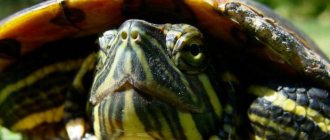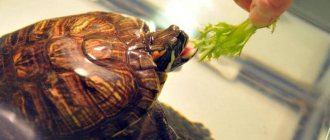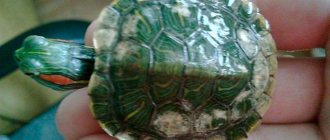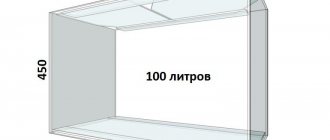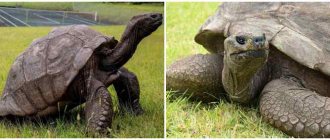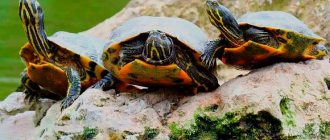Soft shell is a symptom of calcium and vitamin D3 deficiency
Often the presence of a softened shell in an amphibian is accompanied by some other symptoms: redness of the eyes, the appearance of small tubercles and swellings on the protective shell, increased body temperature, bending of the edges of the shell.
The above symptoms can be a consequence of many diseases, namely abnormal thyroid function and intestinal dysfunction. The hardness of a turtle shell is directly affected by the amount of calcium that circulates in the animal's body. It is with a deficiency of this element that deformation of the shell and other symptoms occur. A turtle in this condition cannot be left without treatment, otherwise over time its skull bones will become deformed and the animal will not be able to feed normally.
Calcium deficiency can be caused by a malfunction of the intestines or kidneys, as a result of which the rate of calcium absorption in the amphibian’s body is significantly reduced. Lack of ultraviolet radiation and, as a result, vitamin D deficiency can also lead to softening of the shell in a pet.
Why did the turtle have a soft shell?
A healthy reptile has a hard, even coat, without dips or bumps, and an almost uniform color. Rickets occurs when there is a lack of sunlight or artificial ultraviolet light, with a deficiency of calcium, vitamin D3, if the pet’s diet is monotonous and poor in nutrients. Then the armored tissue of the amphibian becomes pliable, deforms when pressed with a finger, and the marginal scutes bend upward in a dome-shaped manner. It is very risky if the turtle has a soft shell, since the disease must be treated immediately, otherwise the pet may die.
Progression of the disease - complications:
- spontaneous fractures of the limbs;
- prolapse of the cloaca;
- bleeding;
- redness of the mucous membrane of the eyes;
- the reptile cannot rise to its feet;
- disruption of the intestines and kidneys, as a result of which the absorption of calcium into the body stops;
- The amphibian's bite changes, which limits food intake.
At the last stage, death occurs as a result of pulmonary edema, diffuse demorrhage, and heart failure. If a soft shell is observed in a turtle under one year of age, then this is normal - the only exception when there is no need to worry. The shield in babies becomes horny during the first 12 months, gradually turning into reliable protection.
Soft shell of a red-eared turtle
Often, young red-eared individuals after a year are susceptible to this disease. The reason is the lack of natural or artificial lighting in the terrarium. When rickets appears, the armor bends when pressed with a finger. Without treatment, the red-eared reptile's external contour of its head changes - the lower jaw becomes flexible, and the upper jaw resembles a bird's beak. The mouth becomes deformed, the amphibian cannot eat normally. In severe cases, the beak bifurcates and falls off in parts.
Soft shell of a red-eared turtle - what to do:
- Be sure to irradiate it with a UV lamp;
- include raw fish with small bones, multivitamins with calcium and D3 in your diet.
The sea turtle has a soft shell
In such reptiles, the shield has a teardrop-shaped outline; it helps them swim nimbly in the water. A soft shell in a sea turtle indicates non-compliance with the conditions of keeping the amphibian - lack of ultraviolet rays, lack of vitamin D3 and calcium. It is necessary to adjust the pet’s diet using the necessary supplements. The water in the terrarium needs to be changed and a good filter installed.
Soft shell of a land turtle
The low density of the armored tissue of a land reptile indicates a lack of vitamin D3 and calcium in the body and a dysfunction in its absorption. In order to notice the disease in time, you need to regularly pick up your pet and examine it. Land turtle, soft shell - what to do:
- Replenish the amphibian’s body with vitamins D3, not forgetting that an overdose is no less dangerous than a deficiency. The drugs are given once every 2 weeks.
- Calcium supplements are added to the menu at every meal until the pet's condition improves.
- The UV lamp should work in the terrarium for 12 hours a day.
How to cure a pet?
If your turtle exhibits similar symptoms, you can try to take some measures yourself. In summer and warm spring, the pet can be taken out in an aquarium to the balcony or outside and placed in the sun. It is important that direct sunlight does not fall directly on the animal, but illuminates the aquarium well.
During cloudy seasons, in autumn and winter, an aquarium with a turtle should be placed under an ultraviolet lamp for a while, having previously covered the turtle’s eyes with a plaster. This must be done to ensure that radiation and bright light do not damage the organs of vision.
The turtle's diet should be reconsidered: you can add multivitamin complexes containing vitamin D and calcium to it. Shrimp can be a natural source of calcium for turtles. Hard-shell shellfish or minced fish with bones should be added to the animal’s diet.
But if the disease is in an advanced form or the measures taken have not brought the desired result, then the amphibian should be taken to a veterinarian. The doctor will administer a course of injections with vitamin complexes and the condition and appearance of the red-eared slider will improve significantly.
Preventing the disease
To avoid debilitating treatment, it is recommended to follow the rules of feeding and maintenance from the first days of meeting your pet. They are quite simple:
- The diet is selected of high quality, appropriate for the reptile. Food for cats and dogs is absolutely not suitable. Nutrition should include vitamin and mineral supplements, crushed eggshells or bone meal.
- The terrarium is chosen to be spacious and not restrict movement.
- A filter is connected to purify the water.
- In addition to natural lighting, an ultraviolet lamp is installed to maintain the temperature.
- To care for the shell, bathing and rubbing with olive oil are used.
By the way, in natural living conditions, turtles are practically not susceptible to rickets. In other words, a pet’s illness often arises from a lack of attention from the owner. Just take a little more care of your pet, and he will always be healthy.
Preventive measures
The best way to prevent the development of the disease is its prevention. To prevent the red-eared turtle from starting to soften its shell, it is necessary to sunbathe the animal several times a week. A good way to prevent calcium deficiency is to add crushed eggshells to your turtle's daily food several times a week. In winter, when the days outside are cloudy, the turtle needs to be given a solution of vitamin D-3. 3 drops of vitamin D for an adult turtle 2 times a month will completely prevent the development of rickets. The vitamin injection can be given into lumps of food or injected into the animal’s mouth using a medical syringe.
Following the above recommendations is an easy way to keep your turtle healthy. However, if the softening of the shell has already begun, the necessary measures should be taken. After all, rickets, a softening of the shell, can lead to the death of the animal.
Treatment
Rickets is a rather insidious disease. Progressing slowly, the disease gradually destroys the animal’s bones and the body as a whole, which causes unbearable suffering to the pet. Lack of timely treatment leads to the death of the turtle. Medications are prescribed for therapy. The dosage depends on the degree of damage:
First of all, consult your doctor. At stages 1-2 of rickets, a 10% solution of calcium gluconate is administered subcutaneously or intramuscularly, 15 ml per kilogram of the pet’s weight daily for two weeks.
1 ml of Panangin is administered orally every other day for 10 days. Mineral supplements are added to the diet. Daily irradiation with a UV lamp for 10 hours is mandatory.
For treatment of stages 3-4, it is recommended to consult a doctor for inpatient observation. Independent actions are unacceptable due to the risk of an incorrectly selected dosage, which leads to the death of the pet.
Pond slider
The taxonomy of the red-eared turtle species is very confusing. Their shell is relatively flat. The young of these reptiles have a light green tint to their shell; with age, its color changes to light brown or olive, then patterns appear on it that look like vertical yellow stripes, which are especially noticeable in water. Behind the eye of the red-eared turtle there is an elongated red spot. It is thanks to him that it owes its name. Stripes of white and light green colors are observed on the head, neck and limbs of the reptile.
When softness and peeling of the shell is normal
Small turtles develop soft shells until they are 12 months old. By the end of the first year it becomes hard.
Peeling shell may be observed during molting. It does not have time to grow with the reptile's body. Her shell begins to peel, and its scales flake off. Young animals shed up to twice a month. When the cause of a peeling shell is molting, there is no need to panic. The fact that the turtle is molting and not sick is indicated by the absence of other alarming symptoms in the animal, while the pet is active and has a good appetite.
It is important to properly care for the animal during this period. The diet should include foods rich in calcium: shellfish, shrimp, lean fish, which are fed along with entrails and bones. It is recommended to give a multivitamin designed specifically for young turtles. Constantly change the water in the aquaterrarium, otherwise dead tissue will float on the surface and become a good breeding ground for microorganisms, which will cause animal diseases.
If the pet itself cannot remove dead tissue and combs itself, then to help the reptile you can wipe the shell with chamomile infusion.
You can bathe the turtle in a soda solution, which is prepared at the rate of 1 tsp. soda per 1 liter of liquid. For bathing you will need dishes with low sides. There should be enough water in it so that the reptile’s head is located above the liquid. The duration of such a bath is no more than 20 minutes. Then remove the turtle and blot off excess liquid with a towel. Then brush the shell with olive oil.
Molting can only be seen in young individuals that are actively growing. This is a physiological process that indicates that the animal is developing normally. If the shell of an adult turtle peels off, this indicates pathology.
And if not molting, then what?
However, the symptom of turtle shell peeling may indicate other, more serious reasons not related to molting:
- Deformation of the shell due to rickets. Imbalance of vitamin A,
- fungal diseases,
- rickets.
The first ailment is characterized by the formation of ulcers, very severe peeling or flaking of the skin. The scutes peel off from the shell (this does not apply to decorated turtles), and even quite large pieces come off.
An indicator of a fungal disease or dermatitis can be prolonged molting. In an amphibian, the scutes are not completely removed, but under them or on the skin of the animal, areas and sores with a pinkish tint form. White spots appear on the shell of a sick animal. The skin in the folds exfoliates and flakes, causing swelling and pimples. The turtle is suffering from severe itching.
Keep the aquarium clean. The main reason for this misfortune is the violation of the conditions of maintenance, the quality of the water: perhaps its temperature and quality of cleaning are too low. Therefore, first you need to thoroughly clean the aquarium and change the water.
If you notice white spots on a turtle shell, accompanied by peeling, you should show it to a specialist who will recommend effective medications.
Rickets in turtles can cause not only the detachment of shell particles, but also its curvature. This is evidence of a lack of vitamin D3 and calcium in the body, which is fraught with other serious symptoms:
- not only the “body armor” is deformed, but also the paws;
- bones are characterized by increased fragility;
- the cloaca falls out;
- the turtle loses the ability to rise on its legs;
- the mucous membrane of the eyes turns red;
- digestive functions are disrupted;
- the bite changes.
If you are concerned about prolonged molting, consult a doctor. These are life-threatening signs for your turtle. In order not to lead to a sad outcome, it is necessary to start treatment in a timely manner.
If you find a soft shell on a turtle - a sign of rickets, be sure to reconsider its diet. It is necessary to introduce into the diet mixtures containing more calcium and vitamins.
But a mandatory recommendation is an urgent visit to a veterinarian-herpetologist. Only he will competently examine the animal and recommend how to care for it or, if necessary, treat it.
Subcutaneous administration of drugs
Medicines that are not characterized by an irritating effect are perfectly administered subcutaneously.
This process is carried out under the skin at the base of the shoulder or thigh on the medial side. If the leg extends without problems, then the medicine is administered in the area where the inguinal notch of the shell is covered, or in the area where the thigh ends. If this cannot be done, then the medicine is injected at the base of the shell, above the retracted paw. Moreover, the needle is not inserted deeply.
If the turtle is severely dehydrated, then it is not recommended to stab it in the area of the inguinal fossa, since the wall of the bladder may be at a close distance from the skin.
Diarrhea
Diarrhea is most often caused by poor or stale food. In addition, diarrhea may occur due to intestinal injury.
How do I recognize diarrhea?
Feces are mushy, runny, or have a strong odor.
It is necessary to limit food intake for a week. In this case, daily bathing is recommended, in addition, you need to make sure that the animal drinks a lot of water. It is necessary to control the turtle's weight; for this, it is recommended to weigh it regularly. If you do not see any improvement, contact your veterinarian immediately! In the absence of damage to internal organs, the prognosis is positive.
Eye diseases of red-eared turtles and their symptoms
The following symptoms may indicate eye disease in a turtle:
- Redness of the mucous membrane of the eyes.
- Swollen eyelids.
- The appearance of a white coating on the eyeballs.
- The turtle is unable to open his eyes.
- Cloudiness of the cornea.
- Slow reaction of the eyeball to current events.
The above symptoms may be accompanied by general weakness, poor appetite, high fever, and impaired coordination of movements.
Such symptoms indicate the presence of an eye disease such as conjunctivitis. It is caused by bacteria staphylococci and streptococci.
This serious illness can be caused by poor diet or unsanitary conditions. If the water in the aquarium has not been changed for a long time, then the red-eared slider’s eyes will first of all become swollen, which will indicate that the water is polluted.
Another serious turtle eye disease is panophthalmitis. This disease is caused by a purulent infection that affects the tissue of the eyeball. Evidence of such a disease can be clouding of the eyeball, and if appropriate treatment is not started immediately, the turtle may lose its vision.
Causes
The shell should be hard with a smooth surface. In a healthy turtle it has no bumps or dips. To keep reptiles at home, special conditions must be created. Be sure to provide sufficient ultraviolet lighting or, if possible, natural sunlight. Its lack causes a deficiency of vitamin D in the turtle's body. Rickets can also be caused by poor nutrition. If the diet is unbalanced and monotonous, this will lead to calcium deficiency. Accordingly, it will make the shell soft. Its surface will become pliable, with the slightest pressure, dips will appear, the edge flaps will begin to bend upward.
The progression of rickets can cause serious complications, so it is imperative that every owner knows what to do if the turtle has a soft shell. If immediate action is not taken, the following may occur:
Prevention methods
There is one truth that must be adhered to. She claims that it is easier to prevent a disease than to treat it. Therefore, in order not to have to undergo treatment, it is better to regularly carry out preventive measures, which is what experienced owners do. This is especially true when the animal has gastrointestinal disorders or the turtle has contracted an acute respiratory infection and its body spends a lot of energy fighting these ailments.
Prevention is carried out every few months, or maybe more often, depending on the conditions. As a preventative measure, you can use oak bark baths or etch the aquaterrarium with Methylene Blue.
Carrying out preventive measures does not in any way indicate that there is no need to keep the animal in normal conditions. Normal conditions are appropriate temperature conditions, cleanliness and an appropriate diet. Without these three components, it is unlikely that it will be possible to raise a healthy animal. After all, in addition to fungus, pets are also plagued by other, no less serious diseases. All of them are directly related to both nutrition and living conditions.
Arrangement of the aquarium
Maintenance and care do not require a special approach, but you should always remember that turtles of this subspecies can grow up to 20 cm or more in length. Therefore, when arranging a home, this factor should be taken into account so that the turtle does not feel crowded. In this case, take an aquarium that is not tall and not wide, but long enough so that the space can be divided into two parts.
Despite the fact that this species of turtles (yellow-eared and red-eared) are related to aquatic ones, the turtle definitely needs land. You can organize the land in any available way: put a large stone on the bottom of the aquarium so that it looks out from the water or add some soil. In short, the main thing is that the land is above the water level, and the turtle can easily climb onto it. If there is enough space in the aquarium, then you can add soil and plant suitable plants, then the turtle will feel just like in natural conditions. In this case, there is a huge space for the flight of your imagination.
If the vet is out of reach...
Having noticed that the turtle has begun to molt, the owner should examine it and observe carefully. If, in addition to detachment, no other deviations from the norm are identified, the animal behaves actively, there is no reason for concern.
Having discovered that the shell is peeling off very much and even crumbling, you should resort to special treatment, which is prescribed based on the diagnosis. (The symptoms of various “shell troubles” were discussed above).
Fungus. Pharmacies sell antifungal drugs Nizoral or Lamisil. They should be used to lubricate the damaged areas of the shell at night for two weeks, having first very carefully cleaned off the exfoliated tissue.
The fungus can cause irreversible degeneration in the tissues of the turtle “armor”. Such tissues must be carefully cleaned and BetaisodonaR ointment applied to the ulcerated area.
In the case of a fungal disease, “therapeutic baths” are recommended for the amphibian - bathing in chamomile decoction, a weak solution of potassium permanganate or malachite greens. The latter, by the way, is used to disinfect aquarium water.
The disease in its unadvanced stage can be treated quite successfully. If the fungus reaches the internal organs, it can cause the death of the animal.
The shell of a land turtle can peel off as a result of dehydration. In this case, daily bathing of the animal is recommended.
As for rickets, which, as we found out, is the result of a deficiency of vitamin D and calcium, here we are most likely talking not so much about the treatment of the disease, but about its prevention.
So, in the warm season, it is recommended to take the aquaterrarium with the turtle out into the fresh air, while protecting the reptile from direct rays of the daylight.
In the autumn-winter period, turn on the UV lamp. In the autumn-winter period, the dwelling with the amphibian must be placed under a UV lamp three times a week - literally for five minutes.
Before the procedure, it is recommended to cover the turtle’s eyes with a plaster so as not to harm the lens and retina.
To replenish the level of calcium in the reptile’s body, shrimp rich in this element will not be superfluous in its menu. Since this pleasure is not cheap, you can treat your pet with fish and bones instead. Bone meal, crushed egg shells, and chalk are very useful.
If the disease is advanced, the veterinarian, as already mentioned, will prescribe vitamin injections.
Symptoms of the disease
Usually the softness of the shell is accompanied by other signs:
- increased temperature;
- redness of the eyes;
- deformation of the shell and bending of its edges;
- the appearance of tubercles on the shell;
- curvature of the limbs;
- flat or light-colored shell;
- failure of the shell in the rear dorsal part;
- increasing the distance between the upper and lower parts of the shell, which gives the reptile a spherical shape;
- change in bite due to the acquisition of a “duck” beak;
- bifurcation of the beak and falling off of its parts;
- frequent bleeding;
- spontaneous fractures of the limbs;
- prolapse of the cloaca;
- secretion of mucus from the oral cavity;
- paresis of the hind limbs, which leads to a change in gait (the reptile moves on the front legs, and the hind legs drag);
- inability to climb out of the water onto the raft;
- shortness of breath, breathing problems.
- The pet constantly breathes through a half-open mouth.
- Mucus discharge is observed from the mouth and nasal openings.
- Poor appetite or complete refusal to eat.
- While swimming, the animal falls on its side.
The red-eared slider has raised bony plates that look like a hump. When pressing on the plates, they are easily pressed through, gradually returning to their previous place on the owl. If you do not consult a specialist in time and start treatment, the disease will progress. Changes also occur in the head.
What not to use to clean your shell
In addition to the means for cleaning the shell of a red-eared turtle, there are also things that should never be used for this procedure. Their use may harm the health of your pet. Such funds include:
- Shampoo and shower gel;
- Brushes and scrapers;
- Hard sponges;
- Detergents and powder;
- Soap with a strong aroma.
Only at first glance does a turtle shell seem invulnerable. But, in fact, he is quite easy to harm. Therefore, under no circumstances should you use the above mentioned products to wash your red-eared slider. All of them can damage the shell and negatively affect the health of your pet. Also, do not use too cold or too hot water when bathing your pet.

